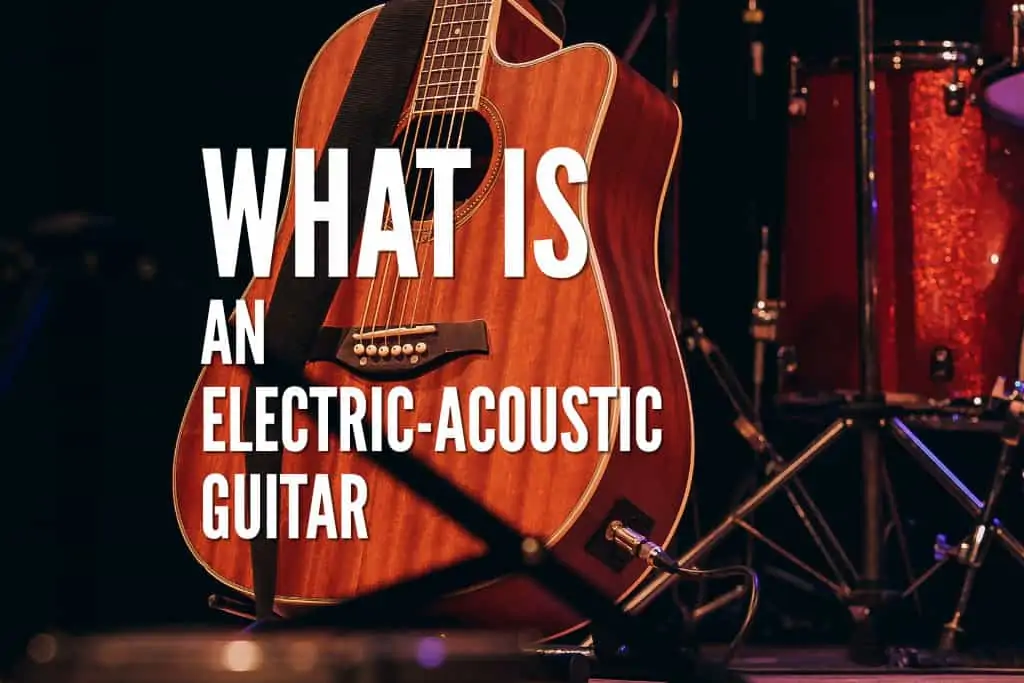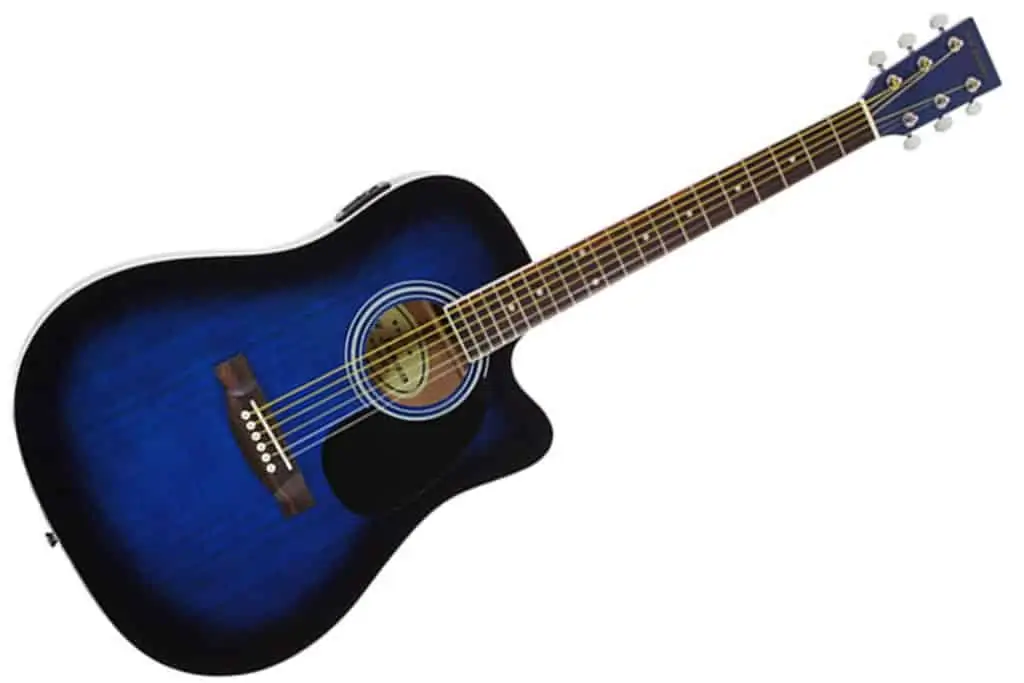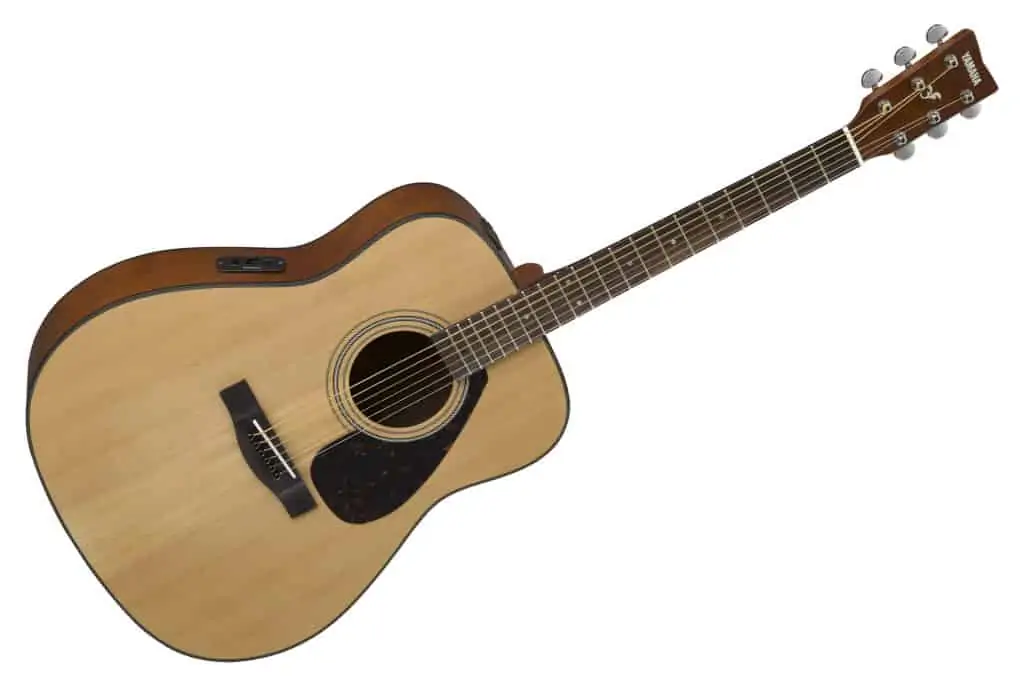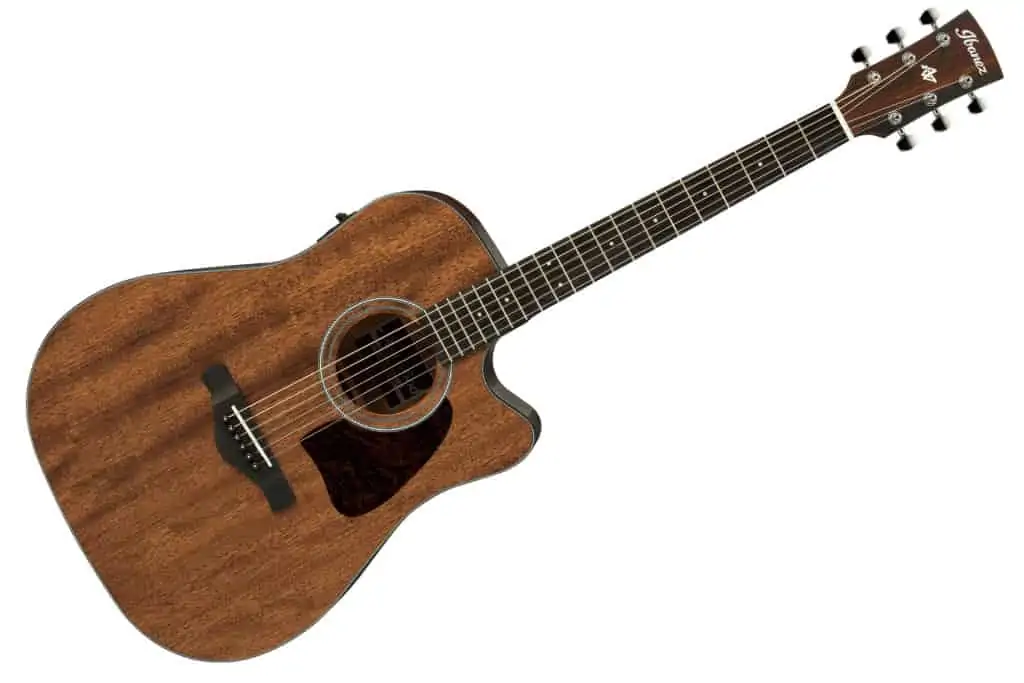The history of the guitar is a very rich one that has been influenced by many unsung heroes. These heroes have taken us from medieval instruments such as the lute or the oud, all the way to wonderful innovations such as resonator guitars, fretless guitars, microtonal guitars and many, many more. One of those majestic inventions is the electric-acoustic guitar, which is now considered one of the most popular instruments in modern music.
So, what is an electric-acoustic guitar? An electric-acoustic guitar is a guitar of acoustic nature that has a built-in pickup, which can be magnetic or piezoelectric. With the help of an amplifier, the electric-acoustic guitar sound is greatly intensified while still maintaining the organic nature that an acoustic guitar would bring but an electric guitar wouldn’t.
Nowadays, this is particularly important for musicians and artists who wish to produce songs that can hone in the intimacy of a steel-string acoustic guitar that an electric one can’t create. By being able to amplify an acoustic guitar, artists are still able to produce enough body and loudness to compete with other instruments. This is especially noticeable in live performances and even more so with singer-songwriters whose main instrument for writing songs turns out to be an acoustic guitar. To demonstrate this, check out how Tommy Emmanuel plays his electric-acoustic guitar.
History Of The Electric-Acoustic Guitar
If we jump back in time, we can find images of instruments that date back to the Mesopotamian and Babylonian Empires 3,000 years ago. These images confirm that string instruments have been a crucial element in mankind’s social and cultural evolution. Two of the most popular instruments back then, as we mentioned, were the European lute and the Arabic oud. The union of both cultures in the year 711AD, when the Moors invaded southern Spain, became a pivotal point in the evolution and eventual creation of the modern guitar. By the end of the Renaissance in the 15th-16th centuries, fretted instruments with a curved silhouette began gaining popularity in favor of the declining lute. The creation of the Baroque guitar became one of the most important predecessors in the history of the modern guitar. By the 1790s, Spanish guitars had been standardized to be 6-stringed instruments and from this point on, the evolution of guitar sped up massively.
If you are considering to start playing guitar and looking for an acoustic guitar on a budget and to save you time searching I made the following post Top 20 Budget Acoustic Guitars Under $100, $150, $200, $300 For Beginners
Coming To America
Decades after the popularization of the Baroque guitar and many alterations of it, European immigrants started bringing steel-stringed versions of the Spanish instrument to America. This was a transcendental step in history and the creation of the electric-acoustic guitar. It was in the 1830s when German-born American luthier, Christian Frederick Martin, made the first modern guitar. This modern guitar was enhanced by a tighter composition of steel strings, giving it much more resonance and changing the style of playing by incorporating a pick to strike the instrument. This would, in turn, make way to new styles of music that were much more bright and chord-driven.
Nevertheless, this is where guitar virtuoso Eddie Lang plays its part in history. Up until that point, the guitar was viewed only as a solo instrument but when Eddie Lang united the guitar with the emerging style we know as jazz, there was suddenly a need to find a way to amplify the guitar’s sound so guitar lines could compete with drums and horns volume-wise. This is how the metal-bodied resonator guitars were created (we have to thank George Beauchamp and John Dopyera for that) but even with that invention, there was still a quest for ways to increase volume and presence for guitars.
Then, a breakthrough. The so much craved device that would change the way music was created forever finally came to our hands. In the early 1930s, legendary engineer and designer Lloyd Loar created the first prototype pickups for acoustic guitars. This device consisted of an electronic mounted in a removable drawer that slid out of the bass rim of the guitar. That same decade, inventor Harry DeArmond created the first commercially available magnetic pickups, which consisted of a magnet wrapped in copper that was affected by the vibrations of the strings. Voilá, the modern guitar pickup is born.
The Birth Of The Electric-Acoustic Guitar
By the 1950s, electric guitars had become a key element in popular music and a brand that truly exploited that was Gibson, especially after the release of their legendary Les Paul guitar. Gibson manufacturers were the first ones to do the attempts at the production of an electric-acoustic guitar. Their model, the J-160e was a round-shouldered dreadnought with a single-coil pickup installed at the end of the fingerboard. This guitar was actually made famous by none other than the Beatles during some of their television performances in the 1960s.
Main Differences Between Electric Guitars And Electric Acoustic Guitars.
It is crucial for anyone who is making the tough decision of whether to buy an electric guitar or an electric-acoustic guitar to understand the differences between them. It can also be very important for someone who wishes to understand the world of guitars a bit better, either for general knowledge or to further their understanding of music production. Naturally, the most obvious similarity is that both can be amplified to enhance their sound, which also means that both can be successfully processed with guitar pedals such as chorus, delays or distortion. A great example of this can be found in Kurt Cobain’s performance of “The Man Who Sold The World”, where he uses slight overdrive on his electro-acoustic guitar.
If you want to hear more songs like this you should check Top 30 MTV Unplugged Rock Performances You Must See
Now in terms of differences, the most interesting one regarding how they both work relies on the way the pickups react to vibrations produced on the guitar. In electric guitars, the vibration of the strings is what interacts with the signal produced by the pickup to make sound, whereas, in an electric-acoustic guitar, it is actually not the strings but the body of the guitar that interacts with a pickup that is installed on the base of the fretboard. Also, an electric-acoustic can work perfectly as an acoustic guitar, meaning that it doesn’t necessarily need to be amplified in a small-audience scenario. Of course, it would still be considered favorable to amplify it so that way small nuances such as embellishments can be accentuated without having to worry about volume. This becomes particularly noticeable with experienced guitar players who rely more on dynamics and various changes of intensity to make their playing richer and more alive.
Since we are mentioning embellishments, another big difference between an electric and an electric-acoustic guitar is the string gauge used. Typically, electric-acoustic strings are far thicker. This is because there is a greater need for resonance in an acoustic guitar for the pickups to react. The downside to this is that there are embellishments such as bends or vibrato that become much more difficult to do on an electric-acoustic. The upside is that it forces you to rely on other embellishments such as trills or just developing a much more rhythmic approach to strumming. Also, you can consider the electric-acoustic guitar a muscle builder for your fretting hand. Once you go back to electric, everything will feel much smoother since you will not need as much strength to produce a desirable sound.
Top 3 Electric Acoustic Guitars Under $300
For all you guitar lovers who wish to expand their arsenal or begin your journey, I have compiled five fantastic suggestions for you that are also pretty affordable. So count your pennies and get ready, because here we go:
Jameson Blue Thinline
Even though the guitar company Jameson is not a very well known one, the Blue Thinline is one of the best products on the market for someone looking for an affordable guitar. Maintaining a lot of fidelity in its sound either plugged in or raw, this guitar features on the list of Amazon’s Choices with a lot of very favorable reviews from satisfied customers. We guarantee you if you buy the Jameson Blue Thinline, you will also be very satisfied.
Yamaha FX325A
For many years, Yamaha has been one of the most reliable guitar companies out there and the FX325A does not disappoint. A well-rounded guitar with all the specs needed for someone who either is a beginner or wishes to get a solid guitar without having to break the bank. It also doesn’t hurt that you have 12 color options that range from blue to red-orange and many others!
Ibanez AW54CEOPN Artwood
Designed with a heavy-duty laminate mahogany top and covered in a warm, yet vibrant darkly tinted wood pattern, this guitar breaks away from the conventional aesthetics pattern. A fantastically built guitar with an eye-catching design and reliable specs is a great option for you guys.
The weight of an acoustic\electric-acoustic guitar is an important factor to its sound it’s comfurt. If you are interested to know how much does an acoustic\electric-acoustic guitar weight you can check out my post How Much Does An Acoustic Guitar Weigh? (14 Examples)
Conclusion
Whether you are one to favor the sound an electric guitar produces vs. the one from an electric-acoustic guitar or vice versa, it is undeniable that both of these wonderful instruments serve different purposes. While the electric guitar is your go-to weapon for raging solos, simple lines for embellishments or rock and roll riffs, the electric-acoustic guitar is a powerful tool for those who wish to focus on songwriting and to be able to have big productions while still maintaining the intimacy that an acoustic guitar brings. In the end, it’s all a matter of taste and we love them both to the bones.
If you found this article useful, you may want to save this pin below to your Guitar board.

Recent Posts
Some guitarists insist on buying an expensive amplifier with their electric guitar. They assume that this is a must for every type of guitarist out there. However, in some situations, this isn’t...
Top 50 Free Realistic Guitar VST Plugins With Sound Examples
As technology has rapidly advanced in the recent decade, computers are stealing more and more roles from physical musical instruments and accessories. Nowadays, you do not need expensive amps,...




